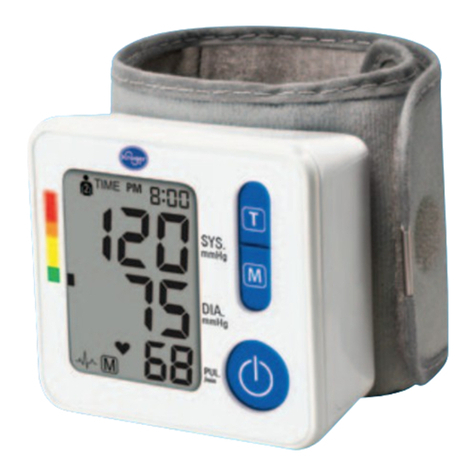Kroger BP3NM1-4NKRO User manual


1
Important Product and Safety Information
Follow Instructions for Use. This document provides
important product operation and safety information
regarding
this Blood Pressure Monitor. Please read this doc-
ument thoroughly before using the device and keep for future
reference.
This blood pressure monitor is an automatic digital blood pressure
measuring device for use by adults on the upper arm at home or in the
doctor’s office. It enables a very fast and reliable measurement of the
systolic and diastolic blood pressure, as well as the pulse rate, by way
of the oscillometric method. This device detects the appearance of
irregular heartbeats during measurement and provides a warning sig-
nal when the irregular heartbeat is detected.
This blood pressure monitor IS intended to be used:
•For self-measurement/monitoring of blood pressure and pulse in adults;
whereas the person being measured may be the user/operator of the
device.
•Within a home healthcare environment.
•With a cuff located upon the user’s upper arm; ½ inch above the
elbow over the artery as indicated on the cuff.
This blood pressure monitor IS NOT intended for use with:
• Pregnancy
• Preeclampsia
•Children under 12
•Neonatal patients
WARNING – Potentially hazardous situation that if not
avoided may result in serious injury or death.
•Self-measuring means monitoring, not diagnosis or treatment.
Unusual
values must always be discussed with your doctor. Under no
circumstances
should you independently alter the dosages of any

drugs prescribed by your physician.
•Consult your physician before using this device if any of the follow-
ing or similar conditions are present: arrhythmias such as atrial or
ventricular premature beats or atrial fibrillation, arterial sclerosis,
poor perfusion, diabetes, age, pregnancy, preeclampsia, renal dis-
eases. Motion during
measurement, including trembling or shivering
may affect the measurement.
•Though not for use with children under 12, ensure that any children
around this device are supervised; some parts are small enough to be
swallowed and any present tubes or cables may provide a risk of
strangulation.
•Ensure the cuff tubing is not kinked during use as harmful injury may
occur due to the effect of blood flow interference caused by high
pressure in the cuff not releasing.
DO NOT:
Use this device if you think it is damaged or anything appears
unusual (e.g. sporadic operation, open packaging upon purchase).
Use the displayed pulse for checking the frequency of heart pace-
makers as this device is not suitable for this action.
Open/modify this device; inaccuracy and/or harmful injury may
result.
Conduct many frequent measurements as this may result in harmful
injury due to blood flow interference.
Place the Cuff over a wound as this may cause additional injury.
Place and pressurize the Cuff over/near any present intravascular
access or therapy, or arteriovenous shunt, as this may cause blood
flow interference and result in harmful injury.
Place and pressurize the Cuff over a limb near the side of a mastec-
tomy as this may cause harmful injury.
Use the Blood Pressure Monitor on a limb simultaneously with other
2

3
medical equipment on the same limb due to possible interference
with such medical equipment.
Maintain pressure in the Cuff applied to the limb for a prolonged
amount of time. Ensure that circulation in the limb is not impaired
by checking circulation if prolonged/repeated exposure to pressure
occurs.
Service the device when being used or when power is supplied.
When the device is not in use and power is removed, cuff assembly,
batteries and AC adapter (if applicable) may be replaced by the user
with Microlife supplied replacements. No other parts/components
are accessible.
CAUTION – Potentially hazardous situation that if not
avoided may result in minor/moderate injury, property
damage, and/or damage to the device
•This device contains sensitive electronics components. Avoid strong
electrical or electromagnetic fields in the direct vicinity of the device
(e.g., mobile telephones, microwave ovens). These can lead to tem-
porary impairment of the measuring accuracy. Move the device to
another location if interference is determined.
•When not using the Blood Pressure Monitor for extended lengths of
time, remove the batteries to avoid potential battery leakage and
damage to the monitor.
•When replacing the batteries, ensure all the batteries are replaced
simultaneously to avoid battery damage and potential damage to the
monitor. Microlife USA does not recommend using rechargeable batteries.
•To avoid inaccurate measurements and to lessen any discomfort
from Cuff pressure, ensure the Cuff is placed correctly on the limb
and fits correctly when snug (not tight), as indicated by markings
with the Cuff.
•Consult your physician in cases of frequent irregular heartbeat detec-
tions.

4
•This Risk Indicator feature is provided in order to help you under-
stand your potential blood pressure risk. However, this feature is
neither a diagnosis nor a substitute for a medical examination. It is
important to consult with your physician to determine your risk.
DO NOT:
Drop this device or expose it to strong vibrations; sensitive compo-
nents may be affected resulting in inaccuracies and/or operational
issues.
Use the Blood Pressure Monitor outside of its specified operation
temperature and humidity rating, or if stored outside of its specified
storage temperature and humidity rating. Avoid storage in direct sunlight.
Use this device in a moving vehicle; inaccurate measurements may
result.
Use third party accessories. Only use Microlife authorized accessories,
such as cuffs or AC adapters, as those not approved for use with the
device may provide inaccurate measurements, injury, and/or damage
the device.
STANDARDS
In addition to the standards stated in the Instruction Manual:
•This medical device is compliant with medical device and non-inva-
sive blood pressure monitor standards IEC 60601-1, IEC 60601-1-2,
IEC 60601-1-11, and AAMI/ANSI/IEC 80601-2-30, and
•Electromagnetic standards IEC 60601-1-2 along with FCC Part 15, and
•Clinical Testing per standard ISO 81060-2:2013 was conducted on
blood pressure device using the same measurement technology.
Please note: According to international standards, your monitor should
be checked for accuracy every 2 years.
Table of contents
Languages:
Other Kroger Blood Pressure Monitor manuals



















